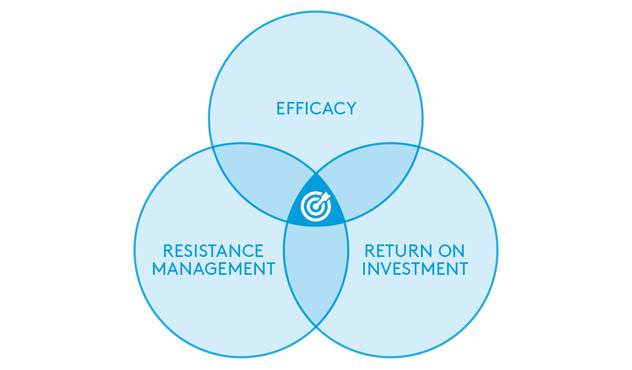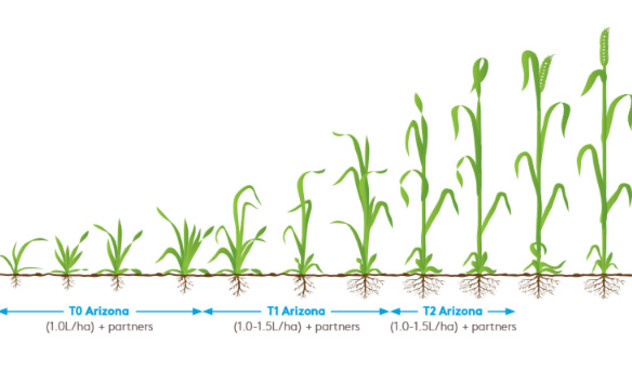
Power-up wheat disease control
We’re focusing on how to power-up your spring fungicide programme by using folpet to deliver three key benefits:
- Improved disease control efficacy
- Protecting at-risk actives by breaking the resistance cycle
- Return on investment
We’ll look at some of the lessons learned in recent years and make recommendations for how to use a diverse range of single and multi-site fungicides - including ARIZONA (500g/L folpet) – to power-up disease control, future-proof the efficacy of resistance-susceptible chemistries and ensure a return on investment through improved crop performance, yield and quality.

Septoria resistance
Azoles
While azoles such as prothioconazole are still important in the fight against septoria, they are no longer fully effective as curative products. In fact, trials have shown that the preventative effect of azoles has reduced by 20% over the last decade, with their curative efficacy reducing by more than 60% on the same period.
Whilst the recent addition to the azole family, Revysol (mefentrifluconazole), isn’t currently affected by sensitivity shifts in the septoria population, it should be noted that it is a single site active ingredient: as such it is at an increased risk to future resistance development and must therefore be protected through an effective resistance management strategy. In essence this means using it in mixture and alternately with an effective single site active with a different target site of activity and in conjunction with a multi-site such as folpet in the programme.
SDHIs
The majority of SDHI (succinate dehydrogenase inhibitor) fungicides still provide effective protection against septoria, but their curative role has become somewhat limited. SDHIs offer broad spectrum control of other foliar diseases but must be used in moderation to protect them from the increasing threat of resistance.
Data from multiple monitoring sites indicates that a number of key strains of septoria throughout England, Scotland and Ireland are becoming increasingly insensitive to current SDHI chemistry.
Multi-sites
Multi-site fungicides remain a vital tool in the control of septoria and as a tool for managing resistance to other modes of action. Active ingredients such as folpet are protectant in action so work best when applied ahead of disease infection.
Multi-site fungicides have no known resistance and remain at a very low risk of resistance developing in cereal pathogens thanks to their ability to affect a number of different metabolic sites within a pathogen.
QiIs (Fenpicoxamid)
As a novel fungicide with a unique site of action, fenpicoxamid doesn’t currently have any known resistance issues. As such it provides both protectant and curative activity against all strains of septoria. However, because fenpicoxamid is a single site active ingredient it is at an increased risk to future resistance development and must therefore be protected through an effective resistance management strategy. As with Revysol (above) this means using it in mixture and alternately with an effective single site active with a different target site of activity and in conjunction with a multi-site such as folpet in the programme.
Future-proofing septoria control
1. Create a diverse fungicide programme
- Use a robust range of fungicide modes of action – including a multi-site tank mix partner such as ARIZONA (500 g/L folpet) – to prevent the over-use and over-exposure of any single active ingredient to the threat of disease resistance and sensitivity shifts.
- Apply SDHI fungicides at their minimum effective dose and number of treatments to provide optimum control and to limit over-exposure which may lead to the selection of further resistant isolates.
- Apply azoles at robust dose rates at T1/T2, but limit the number of azole treatments to reduce the risk of further sensitivity shifts.
2. Integrate cultural control methods to minimise the threat of disease
- Select septoria resistant varieties to reduce the initial risk of infection.
- Delay drilling to prevent early season infections by reducing the crop’s exposure to septoria inoculum.
- Reduce exposure to septoria ascospores by using cultivation and establishment methods which remove volunteers and bury trash and debris from the previous crop.
3. Keep ahead of the disease
- Use disease forecasting tools to predict when crops are at risk from infection so that fungicides can be applied at the optimum timing to provide maximum protection against infection – thereby avoiding the need for curative activity.
- Spray applications must be timed accurately to protect key leaves so that infections are unable to establish. This means using a stacked and sequenced programme of azole, SDHI, QiI and multi-site fungicides to provide a strong protective effect.
- When using a selection of varieties with different levels of disease resistance, spray application timings should be prioritised for the more susceptible varieties: less susceptible varieties will naturally be able to withstand septoria infection for longer, allowing more susceptible varieties to be treated first.
4. Maximise the use of multi-site chemistry
To provide robust levels of protection against septoria in wheat, ARIZONA (500 g/L folpet) should be included in the tank mix at T1 as a priority, and at T0 or T2 depending on the season/risk scenario: the T0 timing will be appropriate if high disease pressure develops early in the season, with the T2 timing more appropriate for providing protection of single site chemistries.
ARIZONA recommendations
ARIZONA can be used at a range of timings, with the T1 timing key in any scenario.
ARIZONA should be considered as the first fungicide application in any crop of wheat, with application rates dependent on the following factors:
- Varietal resistance
- Drilling date
- Location and prevailing climatic conditions
- Disease levels
- Fungicide history and partner products
Typical application rates:
- 1.0-1.5L/ha when used at T1 and T2
- 1.0L/ha at T0
- Maximum total dose 3.0L per crop
In high-risk situations (a susceptible variety, drilled early, growing in wet conditions in an area with a high disease loading), the recommendation is for ARIZONA to be applied at 1.0L/ha at the T0, T1 and T2 timings.

The benefits of including folpet
As a key wheat fungicide, folpet acts on multiple bio-chemical pathways making it less susceptible to resistance. Modelling worked carried out by ADAS has also shown that the inclusion of folpet as a mixture partner can significantly prolong the effective life of prothioconazole and double the life expectancy of fluxapyroxad (SDHI).
Folpet acts on multiple bio-chemical pathways within the fungal cell making it less susceptible to resistance:
- Spore germination inhibitor
- Cell division inhibitor (interferes with nuclear protein synthesis)
- Reduces energy production (disrupts electron transport in mitochondrial respiration)
Folpet is recognised by the Fungicides Resistance Action Group (FRAG-UK) as a valuable tool for managing resistance thanks to its ability to provide added levels and spectrum of disease control which can protect and prolong the lifespan of medium to high resistance risk fungicides like SDHIs.




